Isn't this strange?
It is a tiny part of the current London Fashion and Textile Museum exhibition, which closes on 12th March. It celebrates hangings and quilts using the fabrics of the colourist, Kaffe Fassett. (Can you spot the fragment in this picture of the whole hanging, below?
Kaffe Fassett is obsessed with all kinds of stitching from knitting and crochet to fabric design. Many quiltmakers use his highly detailed fabric to add depth and variety to their work. If you'd like to know more about Kaffe, take a look at this little film, in which he explains what colour means for him.
The show wasn't large, but there was lots to look at because the quilts are both large and also tremendously detailed and intricate. Here, the varied shapes of the patchwork pieces combine with the print of the fabric and the patterns of the stitching, to create something really complex. (This too is just a tiny corner of a much bigger work)
By contrast, the quilt below is all about straight lines, yet it is so lively and full of movement. that it's hard to believe the diamond shaped pieces are of identical shape and size. (They are, though). It's the printed stripiness of the different fabrics that make it jump.
The quilts vary a lot in style and content. Some have been inspired by simple ideas, like the Birds of Paradise" quilt in the American Folk Art Museum . (Click the link to see this famous old quilt, and then compare it with Patty Harants' 2019 "Civil War Bride", below. I think you'll agree that they're so similar, yet so different, in so many ways. )
I won't even try to post everything I noticed in the show, but the zebra below was T's favourite, and one of mine too, so I'll zoom in on it to show you some of the kind of details that blew my mind.
Above is its eye, and below is part of its mane. You may be able to make out that the shading is created using black thread, sewn in a tiny lacy pattern in multiple layers.
Below, on its neck, are flowers, perhaps seaweed and certainly little fishes and sea creatures swimming over the stripes. fascinating once you start looking at everything.
If you stare at the pictures for a while, you'll notice more and more for yourself.
Although it is small, this museum puts on so many good shows and I always keep an eye on it. A quarter of a century ago, it was thought up by the fashion designer Zandra Rhodes, who probably felt London needed a good small fashion museum to rival the Galleria in Paris (a definite must-see when in Paris, even if you aren't that mad on fashion). So Zandra hired a Mexican architect called Ricardo Legorreta to produce a bright orange and pink building in Bermondsey, not far from London Bridge.
In those days, it seemed an odd choice of location, because Bermondsey was then mostly poor and run down, even though it was also full of character and local life. Its many fascinating corners and interesting buildings seemed outnumbered by big council housing estates and run down tenements.
I am sure the museum helped to raise Bermondsey's profile, and maybe that was good. Now the area has deservedly become desirable (though a bit too expensive for my taste). When we emerged, dazzled, from the show, we didn't want to pay £10 each for coffee and cake from the local artisan snack shops, but did want lunch. Luckily old-established Al's Cafe wasn't far away, and for the same price as two sausage rolls and two coffees from the artisans, we got two large well cooked vegetarian lunches and two mugs of tea, served by friendly staff.
Al's Cafe also displays some art work of its own, too - a cheerful relief mural of Tower Bridge on the wall, towering over an unfeasibly blue River Thames. It is full of local people, which is usually a good sign, and I recommend it if you're visiting the museum.
Just around the corner from Al's Cafe is another bit of traditional Bermondsey, an old building whose open plan ground floor is at present a car workshop.

At first, I thought that indicated that the shop had once been a horse-meat butcher. It would have done so in France, for sure - but Brits have never cared for eating horses, so unless this place once served a previously unknown French community, I had to rethink about that. I decided that it must have been a livery stables, caring for horses and hiring out those light carriages called flys, which people took if they didn't want to walk for a few miles.
The change probably came around 1910, when the internal combustion engine blew horse traffic into history. It must have been sad for the many folk who loved working with horses. Perhaps, as they learned to work on the new, noisy, smelly, primitive engines, the owners of this place decided to keep their horse decorations for sentimental reasons?
As we cycled back home across London, it struck me that the poor old place looks shabbier and scruffier than I've seen it for decades. Of course this city has lived through much worse and bounced back, and will again. But I'm not alone in feeling concerned about the feeling that we are getting so poor, and nothing seems to work any more. In fact, this is a topic of conversation which comes up all the time at present. I don't want to get too political here, so thank goodness the Brits haven't taken to the streets and are currently mostly focusing on how to improve matters.
So many people are doing so much to encourage reusing, repairing or just helping others to cope. Our local council has designated certain spots, including local libraries and other public buildings, as "Warm banks" for those who can't afford to heat their homes, and almost every store now has a collection point for the local food bank or food larder (even though the worsening situation is also meaning that many local councils are offering free school meals to kids). Surplus food of all kinds is often well used by organisations providing good cheap or free lunches for anyone who wants to turn up. In fact, while we were searching for lunch in Bermondsey, we could have gone into the beautiful old church (below) and had free tea and cake if we had wanted! (We didn't.)
I'm now getting a bit more involved in activism that will improve matters, and in the spirit of reuse and recycle, T, who trained as an engineer, has started volunteering at Fixing Factory, which helps local people to repair household goods instead of throwing them away. They open twice a week and are very busy and he is enjoying being in the company of other people who also enjoy fixing things.
It's all inspired him to discover even more about how things work, and he's now dug up some interesting videos from the 1980s by Tim Hunkin explaining how common household gadgets do what they do. Hunkin started his career as a cartoonist, then moved to making quirky and amusing automatons. His approach has always been highly original so I have really been enjoying the videos. (Originally shot on 16mm on what appears to be an abandoned airfield covered in junk, a rather dishevelled Hunkin tells you in his own unique way what goes inside your household gadgets. Here is the story of the Washing Machine. )
After being a cartoonist, Hunkin created the extraordinary Under the Pier Show in Southwold, Suffolk, and began collaborating with the Exploratorium in San Francisco. He also has is an interactive gallery of his automata in London's Holborn area and has created (according to T.) some interesting material all about materials and glues. Well, I couldn't quite summon up enthusiasm for watching those, but I was all for going to see the gallery. So last week, on a cold and bitter day, we cycled off to Holborn.
Novelty Automation is full of interactive dioramas and games. Although roughly constructed, some of the automata seem to have minds of their own, and some definitely (shall we say) impinge on your personal space....
The first thing I did when I arrived was prove how brave I am by putting my hand into the cage of a terrifying diamond-tiara'd hound with glowing red eyes (below). I kept my hand in for quite a long time, pulling out only at the last moment just as the hound snarled, growled and finally lunged. As the morning progressed, the place filled up, and the room began ringing with screams as yet another punter's score rose from "Nervous" to "Reckless."
You really have to go there to get an idea of what the place is like, but just to give you an idea, we operated a paparazzi drone to spy on cardboard celebrities in a big white mansion and volunteered for the Amazon Fulfilment Center worker game (You are represented by the pink figure with the arrow pointing to it on the picture below). Just like happens with the real Amazon, you think at first you can cope, then find how hard it is to keep the pace up while the clock counts relentlessly down.
We both tried but ultimately ended up with nothing, except best wishes for finding another job.
T's favourite game, and perhaps mine, was set in a banking district, complete with sound effects, as you try to sneak money past the eyes of the financial regulators into your personal pot. (He managed to make a billion dollars, as you see, LOL).
We went and had lunch after our Novelty Automaton visit in The Cafe in the Crypt of St Martins-in-the-Fields. It's a huge and imposing church whose crypt really does contain a cafe - its profits help subsidise the church's outreach work with drug addicts.
Despite being completely underground, the cafe is a bright and cheerful refuge, the food is good and in this unusually bitter weather it was great to be insulated from the cold outside. Another plus about going there is that there are many other things than food to enjoy. Brass rubbing, concerts, exhibitions and, obviously, some very interesting memorials (it is a crypt, after all). I always say hi to Henry Croft, the first King of the Pearlies who must have been very well worth knowing! And a friend who is a builder once told me that the fine quality of the old brickwork in the crypt gave him huge pleasure. "The guys that built this thought the crypt would always be too dark to see the quality - but they still did it as well as they could," he said. "I find that inspiring."

So now when I go there, I always look up at the bricks, and I feel good about it too.
I have lots to do inside this week, which is just as well because the weather doesn't look good for going out.
I hope the weather's looking better where you are!
,



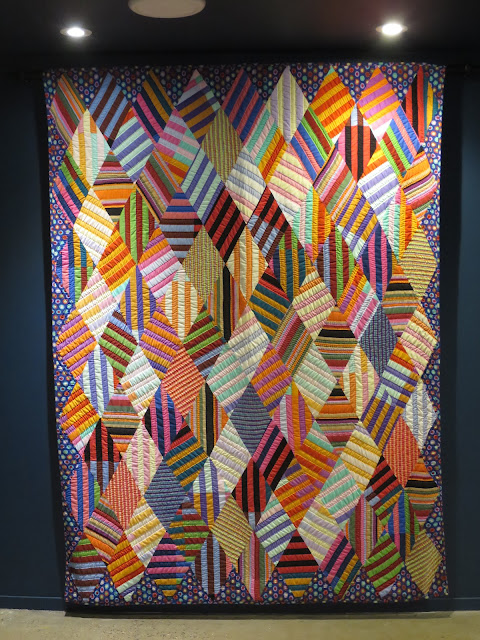


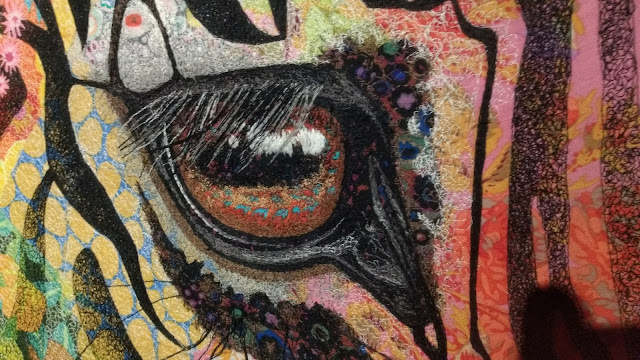



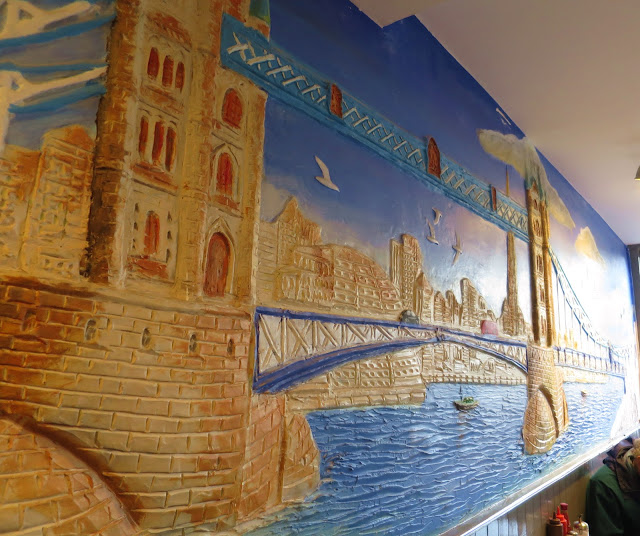

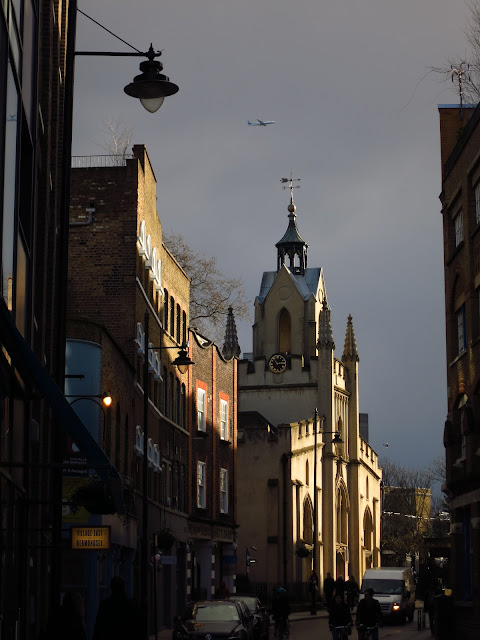


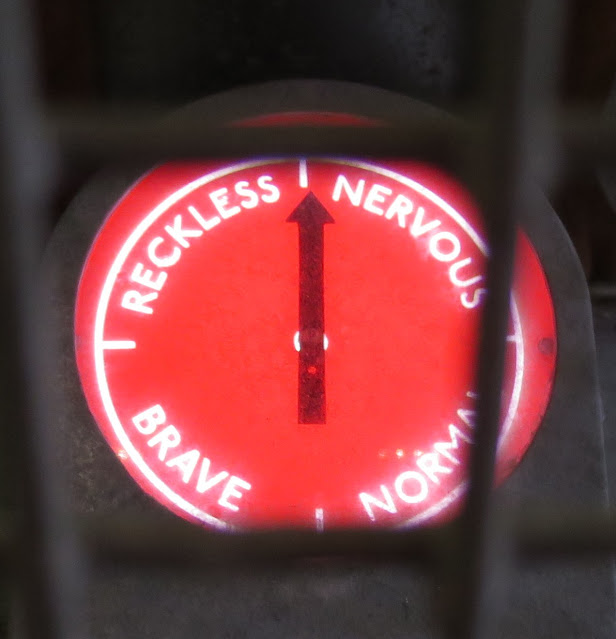





I have beard of Bermondsey but never knew it could be such an interesting place to visit
ReplyDeleteOne of the pleasures of living in London is that it is made up of countless old villages and settlements, and you can often find all kinds of things from past ages. Amazing when you consider how much the poor old place has been knocked about over the centuries!
DeleteI think you probably can guess that I am over the moon with this post. Seeing the Kaffe Fassett exhibit would be beyond amazing. I'm with you on that diamond quilt. You'd never guess those are identical in size without a good deal of looking. What a fabulous optical illusion. And such a good day out as well. Lots of good days out! The Novelty museum sounds like such fun -- very interactive, which is always pretty clever. And now I know an official "billionaire!" I'd probably flunk "Amazon" too -- I'm better at being the one who reaps the benefit of fulfillment. And thank you for more on the Crypt, St. Martin's, and all. It's such a lovely spot and one that brings me lovely memories. So much more to say -- but mostly thank you for this one!
ReplyDeleteThanks Jeanie. Yes, that Kaffe show was thought provoking. I don't see myself being able to copy the sort of things they did, it's just too clever, but it made me think that if I see a bag of fabric scraps in a jumble sale or charity shop, I might try my hand at a fabric collage. I used to do these with different colours of felt and embroidery, but the idea of re-purposing the printed designs on fabric to create something new is interesting. In fact a lot of large churches have started to repurpose parts of the buildings as cafes and they're usually pretty good. Whenever we are in a new area we try to seek them out.
DeleteKaffe Facette is deservedly famous all over the world. I remember first seeing his exhibitions and work more than twenty years ago. Actually, it was not difficult to find the ball in the lower right section, appliqued to top of the appropriate larger ball.
ReplyDeleteYes, I think he was pretty big in the 1990s.
DeleteThis artist is amazing. Every tiny stitch makes the new world.
ReplyDeleteYes. It reminds me of nature, how one can keep looking smaller and smaller.
DeleteAgain, there is so much in this post I don't know where to begin, but one thing reminded me of my cousin's visit last autumn. He had not been to our town in a long time but knew it well from our childhood and youth. During his visit, O.K. and I spent a Saturday with him, strolling across town, having meals, looking at a jumble sale and more. At one point he asked whether it was just his impression or had Ludwigsburg really become much more scruffier than he remembered. He was right, and there have been letters to our local paper about it. The city administration responded by saying that they simply had not enough staff to go round cleaing up after people the way they used to, and also that the pandemic brought a whole new dimension to people leaving plastic and cardboard about from takeaway food during the time restaurants were closed. It is sad, and really not so much down to people (or the city) being poorer than before, but lack of staff, lack of responsibility and lack of manners.
ReplyDeleteApparently the pandemic is largely to blame for the Europe-wide shortage of workers but we have several additional problems right now in UK, for reasons it may be best not to discuss on the blog. Luckily most ordinary people are not blaming each other, but uniting against the government.
DeleteAnother great trip through places not noticed by most of us. Tim Hunkins TV programmes were superb! His attitude all the way through made it watchable. That looks a super place to spend time. St Martins crypt has had many uses, the brickies will be happy with the viewers today, a great job done there. I suppose it is possible that could have been a Horse meat shop, but possibly it was a saddler in times past. That are has been gentrified no end since I last passed by. It is however, easy to read the history just by looking at the cleaned up buildings and aged churches. Your posts always make me want to go to these places, great stuff.
ReplyDeleteTim Hunkin is as you say fantastic, this is not normally my preferred viewing but it was so interesting. I have eaten horse meat in my day (in France) and to be honest it wasn't that bad, not that I am much of a meat eater anyway. But the idea of it is somehow a bit repulsive, I guess because I was brought up to see horses as delightful animals, not something to fill you up at supper time! LOL
DeleteI knew a woman once who did absolutely beautiful guilting but everyone of her quilts was completely neat and tidy and squared up and perfect and I got no feelings from them at all except for sort of wanting to scream. But that was who she was and perhaps she needed to feel that control over at least that small space. These quilts are a completely different matter and sing and soar with their artistry, beauty, and creativity.
ReplyDeleteYou've hit the nail on the head. Interesting though that they take as much fiddly work as the neat n tidy ones. Using the fabric designs as part of the quilt must help to loosen them up, I think that's part of Fassett's idea. He's big on collaboration.
DeleteI admittedly don't know much about quilts, but the colors and patterns on these are absolutely amazing. An incredible amount of thought and work were obviously put into these creations. The zebra is beautiful and unique.
ReplyDeleteYour blog posts are always so informative and filled with so many interesting things .that it's impossible for me to comment on everything. I really like the two photos of the churches that you included - - especially the church in Bermondsey. The contrast between light and darkness is so dramatic.
March is an infuriating month here in rural Tennessee. The temperatures fluctuate drastically. It's 80 degrees (Fahrenheit) one day, then it drops to near-freezing the next. We recently had severe storms with incredibly strong winds. I'm looking forward to spring....
I really love the look of that church. (and actually I took the picture on a different day than our visit, when the light was amazing... one of those dramatic stormy and sunny days. ) We've had slightly Tennessee style weather here in London, but it's very unusual. And it never gets up to 80 at this time of year thank goodness!
DeleteI throughly enjoyed the places you took me to which were, apart from St. Martins in the Fields, off my radar when working in London.
ReplyDeleteThanks. I have noticed the change in St. Martins in the last few years, it's using the church in all kinds of creative ways - they do concerts there too. The music is fairly mainstream I suppose but the atmosphere is wonderful.
DeleteSo nice to see your photographs of Kaffe Fassett exhibition, and very interesting to see around Bermondsey.
ReplyDeleteAll the best Jan
Thanks Jan. I am glad you liked it.
DeleteI learn so much from you, about your city, your culture, and the world. Thank you!
ReplyDeleteThat exhibit is astounding and if i ever get to London again, I want to see that crypt.
Yes, the crypt is nice. It is warm and welcoming but the floor is of memorial stones and there are other memorials in side rooms. It gives a positive feeling to include them in the light, you can read about them and remember that the dead were also once people who lived in this world like us.
DeleteWonderful places. Quilting has become fine art in many of the quilts.
ReplyDeleteThis certainly feels like "art" although some of the quilts would have looked great on beds!!
DeleteWhile I do not know very much, if anything, about quilts, the ones you showed were simply amazing in their craftsmanship and I so admired the talents of the quilters. I watched a couple of the Tim Hunkins videos and they were great fun, so I will introduce my husband to them as well. When we do get to London (hopefully in 2024) that crypt cafe will certainly be on our cafe stops. And, of course, Novelty Automation would be another. Thanks for the tour, Jenny, and good for you on the cycling as well.
ReplyDeleteThanks, Beatrice, I'm glad if I have offered some hints and suggestions for your trip. The crypt is wonderful in winter, or bad weather, and very central, right next to Trafalgar Square. In fact, you can sit on the steps of St Martins of a fine evening and it is a lovely sight with all the people, the fountains and the fine buildings around. Glad too that you like the Tim Hunkins videos and hope your husband also enjoys them.
DeleteHow fantastic to see a Kaffe Fassett exhibition, and those quilts are amazing. The Zebra is unlike any quilt I have ever seen, astonishing. I love the Birds of Paradise quilt too. Kaffe Fassett's fabrics have been available here for a long time and back in the day I made a quilt for our bed from a selection of his beautiful prints. It is something I treasure. Wow, the Novelty Automation place is interesting, and the dog-in-a-tiara rather terrifying. We discovered the crypt at St Martins in the Field on our last visit to London. What a cheerful place, and I love being in a crypt under a cathedral: St Paul's and St Mark's in Venice spring to mind. Great to see you out and having some post-pandemic fun, and sorry to read of the economic effects on the UK. Things are not so good around Oz in financial terms either. Great Post Jenny!
ReplyDeleteI thought the zebra was astonishing too. There was another one by the same artist in the show, of an elephant, which was also good, but somehow the zebra caught my eye. These days many if not most (and large churches) have cafes. As they are all different, you can't generalise but they're all well worth a visit. In Canterbury cathedral the food is limited but you get to sit in the wonderful cloisters of one of the major English cathedrals. In the huge church of Hereford All Saints we had fantastic food and ate amongst little known medieval treasures which astonished us. All Saints is a bit overshadowed by the famous cathederal in Hereford and doesn't get the same publicity I suppose....
DeleteSo much to chew over in this post, where to start? Not being switched into the quilting world, Kaffe Fassett is a new name for me so I was justifiably astonished by his work (I see Patricia above used the same word so it must have been captivating in real life!) Fabric and thread - who knew it could produce such intricate variety?
ReplyDeleteFixing Factory sounds so worthwhile, and sensible! I'm a subscriber to an interesting website, which T may already have heard of, The LowTech Magazine, (which runs on solar power!) and has interesting articles about obsolete technologies and low-tech solutions to all manner of things. Not that I'm planning to implement anything about our diminutive urban flat but I'm fascinated by this sort of diy-can-do-ism.
Thank you Pipistrello, and also for the link to LowTechMagazine which T liked a lot! In fact he put it on the social media group for Fixing Factory because he thought others might like it too. I think you might like the ethical icecream van in Walberswick, Suffolk. Last time I was there it was sunny but blowing a gale straight from the North Sea (typical summer weather in Suffolk I'm afraid) I was too freezing to even think of buying an icecream. But it was doing a good trade without me I am glad to say. They're made of stern stuff up there.
DeleteHello Jenny, Sorry for the delay in commenting, but you sent me down a Tim Hunkin rabbit hole! I have been binge watching him, and even the ones on glue and mechanical parts are just my cup of tea. Thanks for the introduction! --Jim
ReplyDeleteHe's done a good book called Art of Tinkering too. Very entertaining!
DeleteI didn't know about the London Fashion and Textile Museum, Jenny. I would like to see this during my visit to London. I also liked the cafe in the Crypt. I love this church and the crypt where I saw an exhibition of children's work.
ReplyDeleteIndigofera Pendula. Deciduous shrub that prefers well-lit areas. It has a long curved peduncle, up to 30 cm in length. The flowers are collected in a pink-purple cob. it requires shelter and pruning (to a height of up to 15-20 cm) in cold time. After pruning, it is better to mulch the plant. The plant is undemanding to soils. A prerequisite is good drainage. Indigofers feed on the larvae of some insects. Timely treatment with insecticides will protect the plant.
My buddleja, which is a relative of the indigofera, grows well after the spring pruning and blooms.
I am sorry i didn't thank you before for teh information about indigofera Pendula. I wonder if I pruned it at the wrong time of year, reading what you said. It is on quite a warm and sunny wall, in a raised bed. The area used many years ago to be a glassed in bed but all the greenhouse structure is gone, leaving only the raised brick beds behind. I did wonder if its roots are a little cramped, too. It's looking a bit better now, though.
DeleteWow! And Wow! again! A very interesting post, Jenny...from beginning to end. Very interesting, indeed...thank you. :)
ReplyDeleteSO glad you liked it!
DeleteThe quilts are wonderful - so intricate and so colourful. It's good to see traditional (affordable) cafes surviving alongside trendy over-priced coffee shops. I agree with you about the level of poverty and nothing working properly. I read a piece by an Ukrainian who was shocked at the state of the NHS and said Ukrainian health care was far superior, even in the middle of the Russian invasion. And good to see places that are repairing household appliances rather than dumping them and selling you a new one.
ReplyDeleteYes, I think the idea of recycling is catching on. I even saw the Financial Times's "how to Spend it" supplement was doing something a couple of months ago about very rich people recycling their posh clothes. A bit of a gimmick of course, but recycled is definitely cool in all quarters of society at the moment and this can only be good.
DeleteFantastic quilts! They look like a universe of its own and each is really one of a kind. Quilting looks so interesting but the process seems daunting to me, so I haven’t tackled to make it. The Zebra is amazing, indeed! Thanks for showing the details.
ReplyDeleteContrary to London, my place has been unusually warm like early summer. Actually I went outside almost every day like competing with the speed of Sakura blooming and falling. Have nice and happy spring, Jenny.
Yoko
Thank you, Stardust. I have made a quilt with crochet, but it was rather dull really, just lots of squares all the same design but different colours. I hope you enjoyed the Sakura this year. There's an avenue of sakura about 10 minutes walk from our home, and it was interesting in London to see the Japanese people gathered beneath it, just looking at it and enjoying it, standing there and talking with each other.
DeleteOh my, what a wonderful post, Jenny. It is so rich and interesting. I was sad to hear about the shabbiness of the city, though. It feels as if the divide between the haves and have nots is simply increasing, but I so enjoyed seeing the quilts, Al's cafe, the automotive shop with the possible link to the Flys (I wonder if that's where the name Fly boats came from too?) and St Martin-in-the Fields' crypt. I always feel as if I've learnt something new about my home city from you, which is wonderful. I was just wondering, though. Isn't it dangerous to cycle through London?
ReplyDeleteI've never heard of Fly boats, Val, but if they are little boats that take people from place to place, then you are likely to be right. It can be dangerous to cycle in London if you go in heavy traffic, I think and I do try to keep to the cycle routes and quiet streets. If I really hate it I get off and walk for a bit!
DeleteAs always, you never let us down, Jenny! Another very interesting post. Thank you. :)
ReplyDeleteI hope you enjoyed your Easter weekend. I did mine...it was, by choice, spent quietly...just me and my furry mate. Take good care.
I had a nice Easter but it seems a long time ago now.... what you said in a recent post about time flying is so true!
DeleteThe quilts in the first couple of pictures look very 1960s psychedelic.
ReplyDeleteI'd hate to have to make change for that billion dollar bill.
Well, if I had change for it I would be a happy bunny Kirk, LOL!!
DeleteThat was a very interesting post. I enjoy visiting quilt shows and admire the artistry in them, and the patience it takes to create such pieces.
ReplyDeleteI wish I had that kind of patience myself. I'm not a natural craftswoman I'm afraid. :(
DeleteWonderful post. The first quilt was beyond beautiful.
ReplyDeleteThank you Parsnip!
Delete